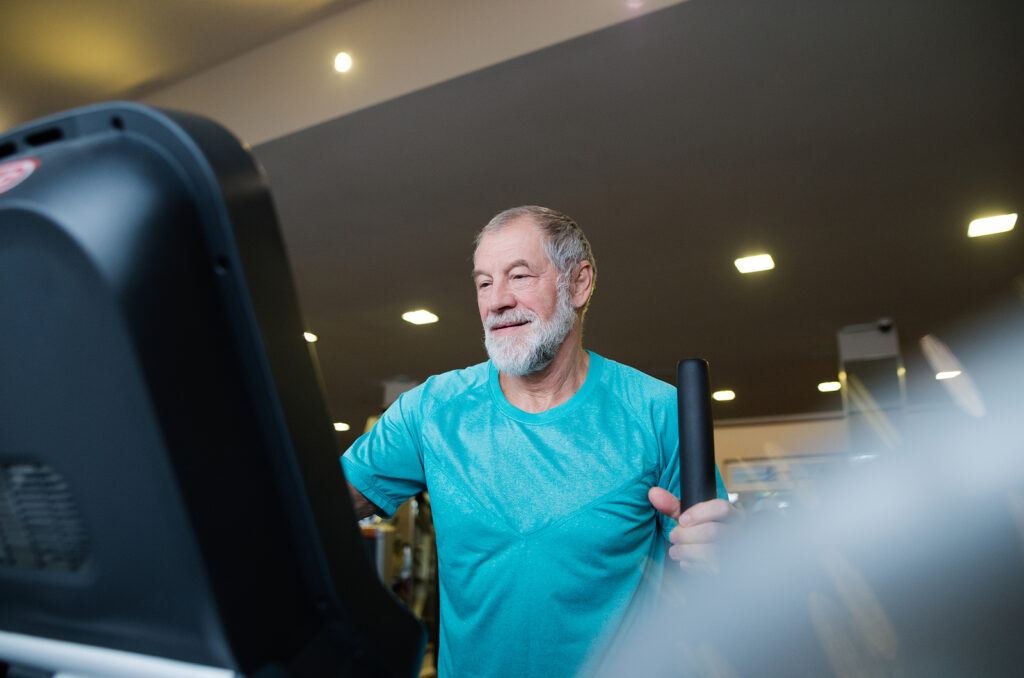An elliptical machine might not be the first idea that comes to mind when thinking about getting a senior-friendly fitness machine, but they’ve got a lot to offer seniors looking to stay fit.
Not only can they provide a low-impact cardio workout, but they can also help improve strength and overall fitness.
And unlike traditional stationary bikes, an elliptical offers a full-body workout, engaging the upper body, lower body, and core at the same time.
Ellipticals offer a lot of workout variety too, giving seniors plenty of different options to choose from.
In this guide, we’ll cover some beginner-friendly elliptical routines perfect for seniors looking to maintain an active lifestyle.
But first things first…
Benefits of Elliptical Workouts for Seniors
Before diving into the routines, it’s helpful to understand why elliptical workouts are so beneficial for seniors in the first place.
Low Impact
One of the primary benefits of using an elliptical machine is that they’re remarkably low-impact and gentle on the joints.
In fact, ellipticals are usually considered one of lowest-impact exercise machines out there (second only to recumbent cross trainers and recumbent exercise bikes.)
The fluid circular motion of the pedals is gentle and the fact that your feet don’t leave the pedals means there’s little stress going through the hips and knees.
Seniors with arthritis or achy joints will appreciate how low-impact these machines are.
Full-Body Workout
Unlike exercise bikes, that focus only on the legs, ellipticals come with moving handles that allow you to exercise your arms as well.
This, combined with the reciprocal arm/leg movement that forces your core to activate, allows an elliptical to provide a full-body workout.
Regular use of an elliptical can help improve cardiovascular health, but it can also help improve upper and lower body strength.
Improved Balance/Coordination
The reciprocal arm/leg movement involved while using an elliptical may help improve a senior’s balance and coordination as well.
The improved strength and circulation that comes with regular use can help improve stability and reduce fall risk.
And considering how devastating a fall can be for seniors, any little advantage can help.
If you’d like to learn about what features to look for when shopping for an elliptical, check out my full guide on the top senior-friendly elliptical machines.
5 Beginner-Friendly Elliptical Routines
1. Warm-Up & Cool-Down
- Duration: 5 minutes (Warm-Up), 5 minutes (Cool-Down)
- Intensity: Low resistance, comfortable pace
- Goal: Prepare the body for exercise and gradually reduce heart rate afterward.
- Tips: Keep the resistance low, focus on smooth and steady movements, and use the handlebars for stability if necessary.
2. Basic Endurance Routine
- Duration: 15 – 30 minutes
- Intensity: Moderate resistance
- Goal: Build cardiovascular endurance and stamina.
- Tips: Maintain a steady pace. Use a moderate resistance that’s challenging, but comfortable. Focus on rhythmic breathing and gradually progress your time as tolerated. Once you can comfortably go for 30 minutes, consider increasing the resistance.
3. Interval Training for Seniors
- Duration: 20 – 30 minutes
- Intensity: Alternate between low and moderate resistance every 2 minutes. You can increase the intensity by increasing the resistance or increasing the incline (if your elliptical has this feature).
- Goal: Improve heart health and burn calories without overexertion.
- Tips: Adjust resistance levels according to comfort. Rest if needed and listen to your body to avoid overexertion.
4. Upper Body Strength Routine
- Duration: 15-20 minutes
- Intensity: Low to moderate resistance
- Goal: Enhance upper body strength by engaging the handles during exercise.
- Tips: Use the moving handlebars to engage arms, shoulders, and chest. Maintain a comfortable pace that allows proper arm movement without strain. Try to initiate the movement by pushing/pulling with your arms (and let your legs just go along for the ride).
5. Incline Workout for Lower Body Strength
- Duration: 20 – 30 minutes
- Intensity: Low resistance with a focus on incline adjustment. Start at a low incline and increase by 1% (or 1 level) every 2 minutes.
- Goal: Target lower body muscles, such as glutes, calves, and thighs.
- Tips: Keep resistance low and focus on increasing the incline gradually. Focus on posture and avoid leaning too heavily on the handlebars.

Safety Tips for Seniors Using Ellipticals
When starting any exercise routine, safety is a priority. Before starting a new elliptical workout, consider the following:
- Check with Your Doctor: Before starting a new workout routine, it’s advisable for seniors to consult with their healthcare provider to ensure they are in good health for exercise.
- Proper Warm-Up: Begin every session with a warm-up to prepare the muscles and joints. Cooling down after the session is equally important to gradually lower the heart rate.
- Monitor Heart Rate: Keep an eye on heart rate to ensure you stay within a safe range. Use built-in monitors if available.
- Focus on Form: Maintain good posture and use the elliptical handles for support. Avoid leaning forward or putting too much pressure on the joints.
- Hydrate: Keep a water bottle nearby to stay hydrated throughout the workout.
Tips for Getting the Most Out of Your Elliptical Workouts
Consistency Is Key
Like any other form of exercise, it’s important to use your elliptical regularly to get the most benefit.
Keep in mind, the National Institute on Aging recommends seniors get at least 150 minutes of moderate-intensity exercise every week.
Seniors can achieve these numbers in different ways, but a popular option is to shoot for 30 minutes of exercise, 5 days a week.
Beginners may want to aim for 3-4 sessions per week and gradually build up as tolerated.
Gradual Progression
Start slow, especially if you’re new to exercise.
Start with low resistances, low incline settings, and shorter durations until you know how your body’s reacting.
Gradually increase resistance, duration, or incline as fitness improves (with a goal of reaching 30 minutes a day, 5 days/week).
Listen to Your Body
It’s important to stay in tune with your body, especially as you start progressing your workouts.
Adjust routines if something feels uncomfortable or too challenging and don’t feel pressured to push past your comfort zone.
And remember, pain isn’t normal – pain during workouts shouldn’t be ignored!
If you feel pain during a workout, take a break and rest for a while.
If the pain persists, see your physician or physical therapist for an assessment.
Wear Supportive Footwear
It’s important to wear comfortable shoes with good support to prevent any discomfort or injuries.
Most seniors will want to wear a nice pair of athletic or tennis shoes for optimal support and comfort.
Avoid wearing sandals, crocs, or any other open-toed shoe, as these can lead to falls or injury during use.
Track Your Progress
Consider keeping a workout log or using a fitness app to monitor your improvements over time, as it can be fun to see how you improve.
Being able to tolerate longer exercise durations is a primary sign of improvement, but you can also track resistance levels, incline settings, and heart rate levels as well.
Contraindications for Seniors Using Ellipticals
While elliptical machines are beneficial for many seniors, there are certain conditions and situations that may make them less appropriate:
- Severe Joint Conditions: Seniors with advanced arthritis or joint disorders might find elliptical movements painful. Consulting a doctor is recommended before starting.
- Balance Issues: Ellipticals require coordination. Seniors with significant balance or vertigo problems might struggle to stay stable, increasing the risk of falls.
- Heart Conditions: Seniors with cardiovascular issues should consult with their healthcare provider, as high-intensity elliptical workouts may put extra strain on the heart.
- Recent Surgeries or Injuries: Recovering from surgery or a recent injury may mean avoiding the elliptical until cleared by a healthcare professional. This is especially true for lower body surgeries like knee or hip replacements.
- Osteoporosis: Advanced osteoporosis can make weight-bearing exercises risky due to fracture concerns. Alternatives like stationary bikes may be safer.
If any of these contraindications apply, consider alternative low-impact exercises, and always seek guidance from a medical professional before starting a new routine.
Final Thoughts
Elliptical workouts are a fantastic way for seniors to maintain fitness, improve cardiovascular health, and strengthen muscles.
These beginner-friendly routines provide a safe and effective way to stay active, promoting longevity and a better quality of life.
Remember, always start at a comfortable pace and build up gradually, respecting your body’s limits and capabilities.
With the right approach, an elliptical can be a valuable tool in a senior’s fitness journey.
I hope you found this guide helpful.
As always, if you have any questions or comments, please leave ’em below and I’ll get back to you shortly.



